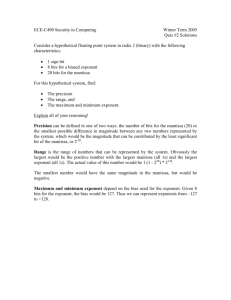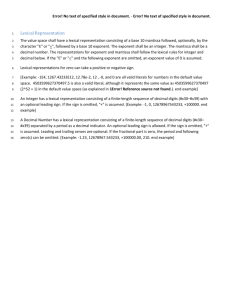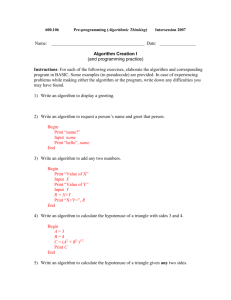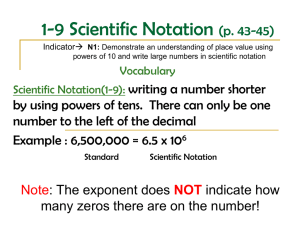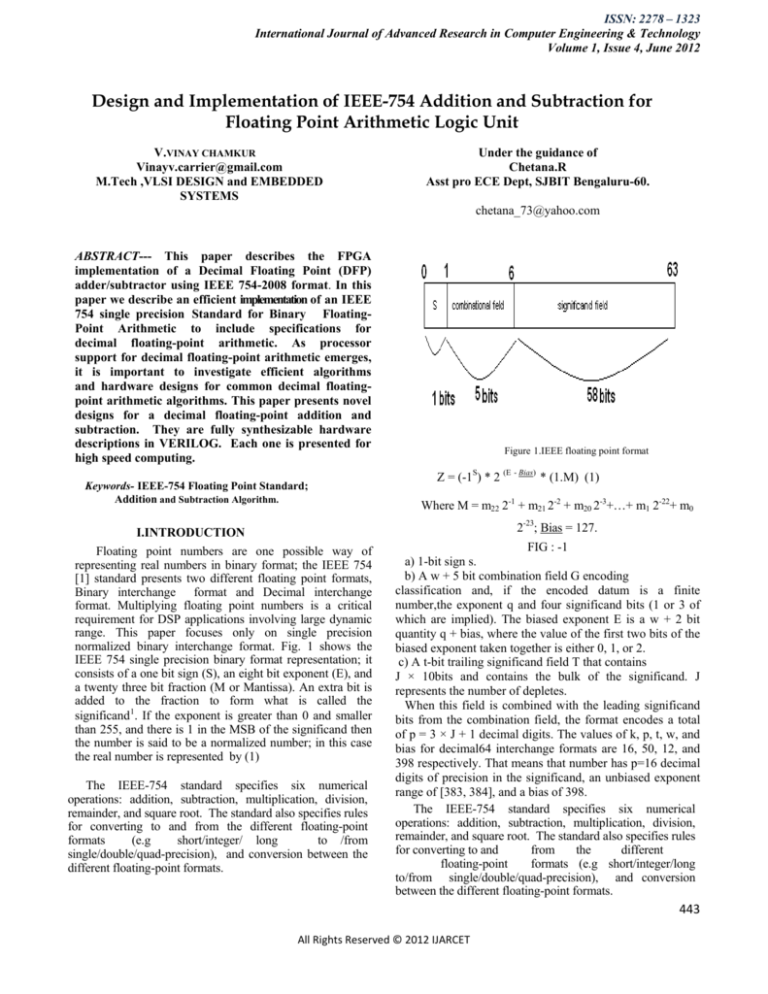
ISSN: 2278 – 1323
International Journal of Advanced Research in Computer Engineering & Technology
Volume 1, Issue 4, June 2012
Design and Implementation of IEEE-754 Addition and Subtraction for
Floating Point Arithmetic Logic Unit
V.VINAY CHAMKUR
Vinayv.carrier@gmail.com
M.Tech ,VLSI DESIGN and EMBEDDED
SYSTEMS
Under the guidance of
Chetana.R
Asst pro ECE Dept, SJBIT Bengaluru-60.
chetana_73@yahoo.com
ABSTRACT--- This paper describes the FPGA
implementation of a Decimal Floating Point (DFP)
adder/subtractor using IEEE 754-2008 format. In this
paper we describe an efficient implementation of an IEEE
754 single precision Standard for Binary FloatingPoint Arithmetic to include specifications for
decimal floating-point arithmetic. As processor
support for decimal floating-point arithmetic emerges,
it is important to investigate efficient algorithms
and hardware designs for common decimal floatingpoint arithmetic algorithms. This paper presents novel
designs for a decimal floating-point addition and
subtraction. They are fully synthesizable hardware
descriptions in VERILOG. Each one is presented for
high speed computing.
Keywords- IEEE-754 Floating Point Standard;
Addition and Subtraction Algorithm.
I.INTRODUCTION
Floating point numbers are one possible way of
representing real numbers in binary format; the IEEE 754
[1] standard presents two different floating point formats,
Binary interchange format and Decimal interchange
format. Multiplying floating point numbers is a critical
requirement for DSP applications involving large dynamic
range. This paper focuses only on single precision
normalized binary interchange format. Fig. 1 shows the
IEEE 754 single precision binary format representation; it
consists of a one bit sign (S), an eight bit exponent (E), and
a twenty three bit fraction (M or Mantissa). An extra bit is
added to the fraction to form what is called the
significand1. If the exponent is greater than 0 and smaller
than 255, and there is 1 in the MSB of the significand then
the number is said to be a normalized number; in this case
the real number is represented by (1)
The IEEE-754 standard specifies six numerical
operations: addition, subtraction, multiplication, division,
remainder, and square root. The standard also specifies rules
for converting to and from the different floating-point
formats
(e.g
short/integer/ long
to /from
single/double/quad-precision), and conversion between the
different floating-point formats.
Figure 1.IEEE floating point format
Z = (-1S) * 2 (E - Bias) * (1.M)
Where M = m22 2-1 + m21 2-2 + m20 2-3+…+ m1 2-22+ m0
2-23; Bias = 127.
FIG : -1
a) 1-bit sign s.
b) A w + 5 bit combination field G encoding
classification and, if the encoded datum is a finite
number,the exponent q and four significand bits (1 or 3 of
which are implied). The biased exponent E is a w + 2 bit
quantity q + bias, where the value of the first two bits of the
biased exponent taken together is either 0, 1, or 2.
c) A t-bit trailing significand field T that contains
J × 10bits and contains the bulk of the significand. J
represents the number of depletes.
When this field is combined with the leading significand
bits from the combination field, the format encodes a total
of p = 3 × J + 1 decimal digits. The values of k, p, t, w, and
bias for decimal64 interchange formats are 16, 50, 12, and
398 respectively. That means that number has p=16 decimal
digits of precision in the significand, an unbiased exponent
range of [383, 384], and a bias of 398.
The IEEE-754 standard specifies six numerical
operations: addition, subtraction, multiplication, division,
remainder, and square root. The standard also specifies rules
for converting to and
from
the
different
floating-point
formats (e.g short/integer/long
to/from single/double/quad-precision), and conversion
between the different floating-point formats.
443
All Rights Reserved © 2012 IJARCET
ISSN: 2278 – 1323
International Journal of Advanced Research in Computer Engineering & Technology
Volume 1, Issue 4, June 2012
, AX and BX are the significands and EAX, EBX and EX
are the exponents respectively. X is a digit that denotes the
outputs of different units. The symbol (N)Z T refers to Tth bit
of the Zth digit in a number N, where the least significant bit
and the least significant digit have index 0. For example,
(A1)2
II. DECIMAL FLOATING POINT IN IEEE 754-2008:The primary difference between two formats, besides the
radix, is the normalization of the significands (coefficient or
mantissa). BFP significands are normalized with the radix
point to the right of the most significant bit (MSB), while
DFP mantissa are not required to be normalized and are
represented as integers. The mantissa is encoded in densely
packed decimal,
The exponent must be in the range [emin, emax], when
biased by bias. Representations for infinity and not-a
number (NaN) are also provided.
Where s is the sign bit, C is the non-negative integer
Significand and q the exponent. The exponent q is obtained
as a function of biased non-negative integer exponent E.
The mantissa is encoded in densely packed decimal [3], the
exponent must be in the range [emin, emax], when biased
by bias. Representations for infinity and not-a-number
(NaN) are also provided. Representations of floating-point
numbers in the decimal interchange formats are encoded in
k bits in the following three fields (Fig1):
III. DECIMAL FLOATING-POINT ADDER
/SUBTRACTOR IMPLEMENTATION
A general overview of proposed adder/subtractor is
described below. For the best performance, the design
presents eight pipelined stages as is exhibited in the Fig. 2.
Arrows are used to show the direction of data flow, the
dashed blocks indicate the main stages of the design, and the
dotted line indicates the pipeline.
This architecture was proposed for the IEEE 754-2008
decimal64 format and can be extended for the decimal128
format. The adder/subtractor on decimal64 is carried out as
follows: The decoder unit takes the two 64-bit IEEE 7542008 operands (OP1, OP2) to generate the sign bits (SA,
SB), 16-digit BCD significant (A0, B0), 10-bit biased
exponents (EA, EB), the effective operation (EOP) and flags
for specials values of NaN or infinity. The signal EOP
defines the effective operation (EOP = 0 for effective
addition and EOP = 1 for effective subtraction), this signal
is calculated as:
EOP = SA xor SB xor OP-------- (2)
As soon as possible the decoded significant become
available, the leading zero detection unit (LZD) takes these
results and computes the temporary exponents (EA1, EB1)
and the normalized coefficients (A1, B1). The swapping unit
swaps the operands (A1, B1) if EA1 < EB1 and Generates
the BCD coefficients A2 (with higher exponent,max(EA1,
EB1)) and B2 (with lower exponent, min(EA1,EB1)). In
parallel with the above mentioned, this unit generates an
exponent difference (Ed = |EA1 - EB1|), the exponent
E2 = max(EA1, EB1), the SWAP flag if a swapping
process is carried out, and the right shift amount (RSA)
which indicates how many digits B2 should be right shifted
in order to guarantee that both coefficients (A2, B2) have
the same exponent.
The RSA is computed as follows:
if (Ed <= p_max)
RSA = Ed
else RSA = p_max
The value p_max = 18 digits, RSA is limited to this
value since B2 contains 16 digits plus two digits which will
be processed to compute the guard and round digit.
Next, the Shifting unit receives as inputs the RSA, and the
significand B2 generating a shifted B2 (B3) and a 2-bit
signal called predicted sticky-bit (PSB) that will predict two
initials sticky bits. PSB and B3 will be utilized as inputs in
the decimal addition, control signals generation and postcorrection units, respectively.
The outputs above mentioned plus two signals,
significand A2 and EOP, are taken as inputs in the control
signals generation unit and generates the signals necessary
to perform an addition or subtraction operation, these
signals are described in the Sub-section 3.4 and are made up
of a prior guard digit (RD2), the final partial sum (S2) and
the corrected exponent (E3).
digit (GD1), a prior round digit (RD1), an extra digit (ED), a
signal which verifies if A2 > B3(AGTB) and a carry into
(CIN).
The significant BCD (A2, B3) and the CIN are
inputs the decimal addition unit generating the partial sum
of magnitude |S1| = |A2 + (-1) EOP B3| and a carry out
(COUT), respectively.
At once, the 16-digit decimal addition unit takes the A2, B3,
EOP and CIN and computes S1 as follows:
S1 = A2 + B3 if EOP = 0, S1 = A2 + cmp9 (B3)
if EOP = 1 and A2 >= B3, and
S1 = cmp9 A2+cmp9(B3)) if EOP = 1 and A2 < B3.
The symbol cmp9 means the 9`s complement.
The post-correction unit uses as inputs the PSB, the
Exponent E2, GD1, RD1, ED, the partial sum S1 and
COUT to verify, correct and compute the inputs signals if
only the following two cases occur: 1) COUT=1 and EOP=0
and 2) (S1)15=0 and (GD1 > 0) and (EOP=1).
The analysis is explained in the Sub-section 3.5.
This unit generates the final sticky bit (FSB), the corrected
guard digit (GD2) and round Next, the Rounding unit takes
the outputs of the prior unit and rounds S2 to produce the
444
All Rights Reserved © 2012 IJARCET
ISSN: 2278 – 1323
International Journal of Advanced Research in Computer Engineering & Technology
Volume 1, Issue 4, June 2012
result´s significand S3 and adjusts the exponent E3 to
calculate the final exponent E4. Simultaneously the
overflow, underflow and sign bit signals
The final sign bit is computed as:
Abstract”, will require you to apply a style (in this case,
italic) in addition to the style provided by the drop down
menu to differentiate the head from the text.
FS = (SA ^ ~EOP) V (EOP ^ (AGTB ⨁ SA ⨁ SWAP))
IV.
PROBLEMS ASSOCIATED WITH
FLOATING
POINT
ADDITION
&
SUBTRACTION
For the input the exponent of the number may be
dissimilar. And dissimilar exponent can’t be added directly.
So the first problem is equalizing the exponent. To equalize
the exponent the smaller number must be increased until it
equals to that of the larger number. Then significant are
added. Because of fixed size of mantissa and exponent of the
floating-point number cause many problems to arise during
addition and subtraction. The second problem associated with
overflow of mantissa. It can be solved by using the rounding
of the result. The third problem is associated with overflow
and underflow of the exponent. The former occurs when
mantissa overflow and an adjustment in the exponent is
attempted the underflow can occur while normalizing a
small result. Unlike the case in the fixed-point addition, an
overflow in the mantissa is not disabling; simply shifting the
mantissa and increasing the exponent can compensate for
such an overflow. Another problem is associated with
normalization of addition and subtraction. The sum or
difference of two significant may be a number, which is not
in normalized form. So it should be normalized before
returning results
V.ADDITION AND SUBTRACRION ALGORITHM
Let a1 and a2 be the two numbers to be added. The
notations ei
and si
are used for the exponent and
significant of the addends ai. This means that the floatingpoint inputs have been unpacked and that si has an explicit
leading bit. To add a1 and a2, perform these eight steps:
1. If e1 < e2, swap the operands. This ensures that the
difference of the exponents satisfies d = e1–e2 0.
Tentatively set the exponent of the result to e1.
2. If the sign of a1 and a2 differ, replace s2 by its
two’s complement.
3. Place s2 in a p-bit register and shift it d = e1-e2
places to the right (shifting in 1’s if the s2 was
complemented in previous step). From the bits shifted out,
set g to the most- significant bit, r to the next mostsignificant bit, and set sticky bit s to the OR of the rest.
4.
Compute a preliminary significant S = s1+s2
by adding s1 to the p-bit register containing s2. If the
signs of a1
Figure 2: implementaition diagram are generated.
445
All Rights Reserved © 2012 IJARCET
ISSN: 2278 – 1323
International Journal of Advanced Research in Computer Engineering & Technology
Volume 1, Issue 4, June 2012
,
exponent. This is the significant of the result.
8.Compute the sign of the result. If a1 and a2 have the same
sign, this is the sign of the result.If a1 and a2 have different
signs, then the sign of the result depends on which of a1, a2
is negative, whether there was a swap in the step 1 and
whether S was replaced by its two’s complement in step 4.
As in table below
and a2 are different, the most-significant bit of S is 1,
and there was no carry out then S is negative. Replace S
with its two’s complement. This can only happen when d =
0.
5. Shift S as follows. If the signs of a1 and a2 are
same and there was a carry out in step 4, shift S right by
one, filling the high order position with one (the carry out).
Otherwise shift it left until it is normalized. When left
shifting, on the first shift fill in the low order position with
the g bit. After that, shift in zeros. Adjust the exponent of
the result accordingly.
6. Adjust r and s. If S was shifted right in step 5, set r:
= low order bit of S before
shifting and s: = g or r or s. If there was no shift, set r: =
g, s: = r. If there was a single left shift, don’t change r and s.
If there were two or more left shifts, set r: = 0, s: = 0. (In the
last case, two or more shifts can only happen when a1 and
a2 have opposite signs and the same exponent, in which
case the computation s1 + s2 in step 4 will be exact.)
7. Round S using following rounding rules as in Table ;
Rounding
Sign of result 0 Sign of result <0
Mode
-
+1 if r s
+ +1 if r s
0
Nearest
+1 if r p0 or r +1 if r p0 or r
s1 to the low orders
If a table entry is non empty, add
bit of S.
If rounding causes carry out, shift S right and adjust the
Swap Compleme Sign (a1) Sign
Sign
Y
+
nt
(a-2)
(result)
es
+
+
Y
+
+
N
es
+
o
N
+
o
+
+
N
N
oVI. SPECIAL CONDITIONS
o
N
Some special conditions are checked before processing.
Y is met then we have no need to calculate the
o condition
If any
e procedure. Results are directly calculated.
N
result by normal
s
Sooall the operations
are bypassed when any such condition
is met.
1. If a1Y= 0 and a2 = 0 then result will be zero.
2. If a1e= a2 and sign of a1 sign of a2 then result
will be again zero.
s
3. If a1 = 0 and a2 0 then result will be equal to
a2.
4. If a2 = 0 and a1 0 then result will be equal to a1.
5. If d = |e1 – e2| > 24 then result will be equal to larger
of a1 and a2.
VII.Hardware Approach
The block diagrams of the architecture used for
combinational adder is shown above in
Figure 4, step by step from the lower abstract level to
the higher abstract level.
446
All Rights Reserved © 2012 IJARCET
ISSN: 2278 – 1323
International Journal of Advanced Research in Computer Engineering & Technology
Volume 1, Issue 4, June 2012
B Unsigned Adder (for exponent
addition)
This unsigned adder is responsible for adding the
exponent of the first input to the exponent of the second
input and subtracting the Bias (127) from the addition
result (i.e. A_exponent + B_exponent - Bias). The result of
this stage is called the intermediate exponent. The add
operation is done on
8 bits, and there is no need for a quick result because most
of the calculation time is spent in the significand
multiplication process (multiplying 24 bits by 24 bits); thus
we need a moderate exponent adder and a fast significand
multiplier.
An 8-bit ripple carry adder is used to add the two input
exponents. As shown in Fig. 3 a ripple carry adder is a
chain of cascaded full adders and one half adder; each full
adder has three inputs (A, B, Ci) and two outputs (S, Co).
The carry out (Co) of each adder is fed to the next full
adder (i.e each carry bit "ripples" to the next full adder).
Figure 5 : - ripple carry adder
The addition process produces an 8 bit sum (S7 to S0) and a
carry bit (Co,7). These bits are concatenated to form a 9
bit addition result (S8 to S0) from which the Bias is
subtracted. The Bias is subtracted using an array of ripple
borrow subtractors.
A normal subtractor has three inputs (minuend(S),
subtrahend (T), Borrow out (Bo)).The subtractor logic can be
optimized if one of its inputs is a constant value which is our
case, where the Bias is constant (127|10 = 001111111|2).
S
T
Bi
Difference(R)
Bo
0
1
0
1
1
1
1
0
0
0
0
1
1
0
1
1
1
1
1
1
Input 2 = 00111111100101100110011001100110
(1.175 10)
Required Result =
01000000100010010111000010100011
(4.295 10)
Obtained Result =
01000000100010010111000010100011 (4.295 10)
Input 1 = 01000000100010000000000000000000 (4.25
10)
Input 2 = 01000001010010000111101011100010
(12.53 10)
Required Result =
01000001100001100011110101110000 (16.78 10)
Obtained Result =
01000001100001100011110101110001 (16.78 10)
FLOATING POINT SUBTRACTOR
Input 1 = 01000001100001100011110101110000
(16.78 10)
Input 2 = 01000000100010000000000000000000 (4.25
10)
Required Result =
01000001010010000111101011100010 (12.53 10)
Obtained Result =
01000001010010000111101011100010 (12.53 10)
The above table shows one bit subtractor
VIII.SIMULATION RESULTS
FLOATING POINT ADDER
Input 1 = 01000000010001111010111000010100
(3.120 10)
Input 1 = 01000001100101010110011001100110
447
All Rights Reserved © 2012 IJARCET
ISSN: 2278 – 1323
International Journal of Advanced Research in Computer Engineering & Technology
Volume 1, Issue 4, June 2012
(18.675 10)
Input 2 = 01000000100101010111000010100011
(4.670 10)
Required Result =
0100000101100000000101000111101 (14.005 10)
Obtained Result =
0100000101100000000101000111101 (14.005 10)
IX.IMPLEMENTATION AND TESTING
The whole adder (top unit) was tested against the
Xilinx floating point adder core generated by Xilinx
coregen. Xilinx core was customized to have two flags to
indicate overflow and underflow, and to have a maximum
latency of three cycles. Xilinx core implements the “round
to nearest” rounding mode.
A testbench is used to generate the stimulus and
applies it to the implemented floating point adder and to the
Xilinx core then compares the results. The floating point
multiplier code
was
also checked
using
DesignChecker
[7]. DesignChecker is a linting tool
which helps in filtering design issues
like gated
clocks, unused/undriven logic, and combinational loops.
The design was synthesized using Precision
synthesis
tool [8] targeting Xilinx Virtex-5 ,5VFX200TFF1738
with a timing constraint of 300MHz. Post synthesis and place
and route simulations were made to ensure the design
functionality after synthesis and place and route. shows the
resources and frequency of the implemented floating
point multiplier and Xilinx core
Clk
Delay Mops
Cycles
/
(GHz)
(ns)
se 6.
Itanium2 [18]
1.
21
156.
c 22.
4
9
4
4
Xeon5100 [19]
3.
13
44.
0
3
3
6
Xeon [18]
3.
24
77.
12.
2
9
8
91.
1.
848
565.
Pentium M [21]
5
3
8
Power6 [22]
5.
1
3.
294.
0
7
4
1
Z10 [23]
4.
1
2.
366.
4
7
7
BID 65nm [10]
1.
3-2
10.
100.
3
13
0
09.
BID Virtex 5 [9]
0.1
13109.
6
18
8
1
Proposed Virtex5
0.
8
40
200.
2
0
HW
SW
Technology
The area of Xilinx core is less than the
implemented floating point
adder because the
latter doesn‟ t truncate/round the 48 bits
result of the mantissa multiplier which is reflected in the
amount of function generators and registers used to perform
operations on the extra bits; also the speed of Xilinx core is
affected by the fact that it implements the round to nearest
rounding mode.
X. CONCLUSIONS AND FUTURE WORK
This paper deals with development of a Floating Point
adder and subtractor for ALU in VHDL and verilog with
the help of ModelSim and synthesized with Xilinx tools.
Simulation results of all the designed programs have been
carried out for various inputs with the help of ModelSim
tool. Both are available in single cycle and pipeline
architectures and fully synthesizable with performance
comparable
to
other
available
high
speed
implementations. The design is described as graphical
schematics and VHDL code. This dual representation is
very valuable as allows for easy navigation over all the
components of the units, which allows for a faster
understanding of their interrelationships and the
different aspects of a Floating Point operation.
References
[1]M. F. Cowlishaw, “ Decimal floating-point: algorism for
computers,” inProc.6th IEEE Symp. Computer
Arithmetic, 2003, pp. 104– 111.
[2] E. M. Schwarz, J. S. Kapernick, and M. F.
Cowlishaw,“ Decimal floating-point support on the IBM
System z10 processor,” 2009, iBM Journal of
Research and Development.
[3]IEEE Standard for Floating-Point Arithmetic,” pp. 1– 58,
2008, iEEE Std 754-2008.
[4] F. Y. Busaba, C. A. Krygowski, W. H. Li, E. M. Schwarz,
and S. R. Carlough, “ The IBM z900 decimal arithmetic
unit,” in Proc. Conf Signals, S ystems and Computers
Record of the Thirty-Fifth Asilomar Conf, vol. 2, 2001,
pp.1335– 1339.
[5] W. Haller, K. Ulrich, L. Thomas, and H. Wetter,
“ Combined binary/decimal adder unit,” in International
Business Machines Corporation (Armonk, NY), 1999.
[6]
G. Bohlender and T. Teufel, “ BAP-SC:
A
Decimal Floating-Point
Processors
for
Optimal
Arithmetic,”
in Computerarithmetic:
Scientific
Computation
[7]
J. Thompson, N. Karra, and M. J. Schulte, “ A 64bit decimal floating-point adder,”
in Proc. IEEE
Computer
society Annual Symp. VLSI, 2004, pp.
297– 298.
[8] M. S. Cohen, T. E. Hull, and V. C. Hamacher,
“ CADAC: A Controlled-Precision Decimal Arithmetic
Unit,” no. 4, pp.370– 377, 1983.
[9] A. Farmahini-Farahani, C. Tsen, and K. Compton, “ FPGA
implementation of a 64-Bit BID-based decimal floatingpoint adder/subtractor,”
in Proc. Int. Conf. F
ield- Programmable Technology FPT 2009, 2009, pp.
518– 521.
448
All Rights Reserved © 2012 IJARCET
ISSN: 2278 – 1323
International Journal of Advanced Research in Computer Engineering & Technology
Volume 1, Issue 4, June 2012
[10]
C. Tsen, S. Gonzalez-Navarro, and M. Schulte,
“ Hardware design of a Binary Integer Decimal-based
floating-pointadder,” pp. 288– 295, 2007, computer
Design, 2007. ICCD2007.
[11] C. Minchola and G. Sutter, “ A FPGA IEEE-754-2008
Decimal64 Floating-Point
449
All Rights Reserved © 2012 IJARCET




